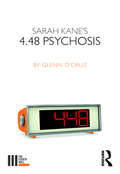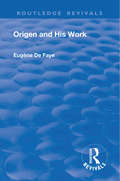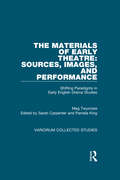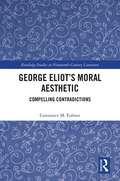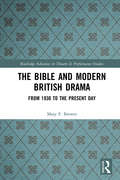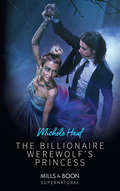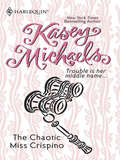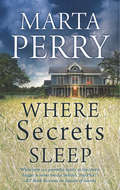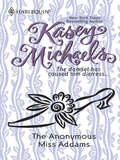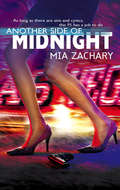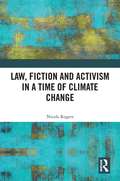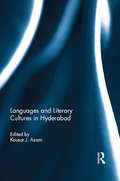- Table View
- List View
Sarah Kane's 4.48 Psychosis (The Fourth Wall)
by Glenn D'Cruz"Everything passes/Everything perishes/Everything palls" – 4.48 Psychosis How on earth do you award aesthetic points to a 75-minute suicide note? The question comes from a review of 4.48 Psychosis’ inaugural production, the year after Sarah Kane took her own life, but this book explores the ways in which it misses the point. Kane’s final play is much more than a bizarre farewell to mortality. It’s a work best understood by approaching it first and foremost as theatre – as a singular component in a theatrical assemblage of bodies, voices, light and energy. The play finds an unexpectedly close fit in the established traditions of modern drama and the practices of postdramatic theatre. Glenn D’Cruz explores this theatrical angle through a number of exemplary professional and student productions with a focus on the staging of the play by the Belarus Free Theatre (2005) and Melbourne’s Red Stitch Theatre (2007).
From Medievalism to Early-Modernism: Adapting the English Past
by Marina Gerzic Aidan NorrieFrom Medievalism to Early-Modernism: Adapting the English Past is a collection of essays that both analyses the historical and cultural medieval and early modern past, and engages with the medievalism and early-modernism—a new term introduced in this collection—present in contemporary popular culture. By focusing on often overlooked uses of the past in contemporary culture—such as the allusions to John Webster’s The Duchess of Malfi (1623) in J.K. Rowling’s Harry Potter books, and the impact of intertextual references and internet fandom on the BBC’s The Hollow Crown: The Wars of the Roses—the contributors illustrate how cinematic, televisual, artistic, and literary depictions of the historical and cultural past not only re-purpose the past in varying ways, but also build on a history of adaptations that audiences have come to know and expect. From Medievalism to Early-Modernism: Adapting the English Past analyses the way that the medieval and early modern periods are used in modern adaptations, and how these adaptations both reflect contemporary concerns, and engage with a history of intertextuality and intervisuality.
Fictive Narrative Philosophy: How Fiction Can Act as Philosophy (Routledge Research in Aesthetics)
by Michael BoylanWhat is the philosophical voice within literature? Does literature have a voice of its own? Can this voice really be philosophical in its own right? In this book, Michael Boylan argues that some literary works indeed can make their own unique claims in different areas of philosophy. He calls this method fictive narrative philosophy. The first part of the book presents an overview of traditional thinking about philosophy and literature across classical, modern, and contemporary periods. It does not seek to denigrate these methods of studying literature, but rather to ask more of them. The second part then sets out a rigorous definition of what constitutes fictive narrative philosophy. This definition outlines detailed conceptions of the methods of presentation, audience engagement, logical mechanics, and constructional devices of fictive narrative philosophy. The author brings this definition to bear on individual authors and works that can be considered prime examples of fictive narrative philosophy. Finally, the book sets out why and when fictive narratives might be more favorable than traditional philosophical discourse, and how the concept of fictive narrative philosophy can move teaching and scholarship forward in a positive direction. Fictive Narrative Philosophy presents an entirely new and unique approach in which literature can be a form of philosophy. It will appeal to scholars and upper-level students interested in philosophy and literature.
Revival: Origen and his Work (Routledge Revivals)
by Eugene de FayeLast year (1925) the Olaus Petri Endowment greatly honoured the author by inviting him to deliver a few lectures on Origen at the University of Upsala. It was agreed that they should be published and we now offer them to the public exactly as they were delievered. There could be no question of expounding the entire thought of Origen in eight conferences. We have been compelled to pass over more than one important doctrine - for instance, his ideas on the Gnosis. Still less was it possible to set forth in these lectures the enormous mass of documents upon which our exposition of the theology of Origen is based.
The Wounded Hero in Contemporary Fiction: A Paradoxical Quest (Routledge Studies in Contemporary Literature)
by Susana Onega Jean-Michel GanteauThe Wounded Hero in Contemporary Fiction tracks the emergence of a new type of physically and/or spiritually wounded hero(ine) in contemporary fiction. Editors, Susana Onega and Jean-Michel Ganteu bring together some of the top minds in the field to explore the paradoxical lives of these heroes that have embraced, rather than overcome, their suffering, alienation and marginalisation as a form of self-definition.
The Materials of Early Theatre: Shifting Paradigms in Early English Drama Studies (Variorum Collected Studies)
by Meg TwycrossCollected Studies CS 1068 The essays selected for this volume are chosen to reflect the important and intersecting ways in which over the last forty years Meg Twycross has shifted paradigms for people reading early English religious drama. The focus of Meg Twycross’s research has been on performance in its many aspects, and this volume chooses four of the most important strands of her work - the York plays; new ways of understanding acting and performance in late medieval theatre, particularly in Britain and across Europe; why scenes are staged in the ways they are, verbally and by extrapolation visually, by close reading of texts against the background of medieval theology; and the attention paid to wider contexts of medieval theatre - concentrating especially on essays that are not easily available today. These thematic strands are reflective of Meg Twycross’s major contribution to the field. They also represent those areas from her wider work which will have most utility and value for those, whether students or senior specialists in areas beyond early drama, who are looking for ways into understanding English medieval plays. The crucial work that has been done here has opened new perspectives on late medieval theatre, and will allow new generations to begin their study and research from further along the road.
George Eliot’s Moral Aesthetic: Compelling Contradictions (Routledge Studies in Nineteenth Century Literature)
by Constance M. FulmerGeorge Eliot’s serious readers have been intrigued by the fact that she declared that she had lost her faith in God and had renounced her hope for a traditional Christian heaven and yet she continued to preach her own version of morality in everything she wrote, to hope for an immortality which allowed her to join an invisible choir which would influence generations to come, and to be concerned about the moral growth of her characters. This is only one of the many compelling contradictions in her life and in her artistry. This volume aims to investigate Eliot’s ethical and artistic principles by defining her moral aesthetic as it relates to her self-concept and exploring Eliot’s narrative decisions and the decisions made by her characters and the circumstances which prompt those choices. Dr. Fulmer includes chapters on her clerical figures and other types of individuals such as musicians, and politicians. Dr. Fulmer also illuminates the paradoxes and contradictions in George Eliot’s life and in her philosophy by focusing on Eliot's use of animals, mirrors, windows, jewelry, wills and other tangible images in her poetry as well as her novels. George Eliot’s Moral Aesthetic contends that everything about her moral philosophy is related to her writing and that everything about her writing is related to her moral philosophy.
The Bible and Modern British Drama: From 1930 to the Present Day (Routledge Advances in Theatre & Performance Studies)
by Mary F. BrewerThe Bible and Modern British Drama: 1930 to the Present Day is the first full-length study to explore how playwrights in the modern period have adapted popular biblical stories, such as Abraham and Isaac, Moses and the Exodus from Egypt, and the life and death of Jesus, for the stage. The book offers detailed and accessible interpretations of the work of well-known dramatists such as Christopher Fry, Howard Brenton, and Steven Berkoff, alongside the work of writers whose plays have been neglected in recent criticism, such as James Bridie and Laurence Housman. The drama is analysed within the context of changes in religious belief and practice over the course of the modern period in Britain, comparing plays that approach the Bible from a traditional religious perspective with those that offer alternative viewpoints on the text, including the voices of gay, feminist, black, Jewish, and Muslim dramatists. In doing so, the author offers a broad and in-depth exploration that is grounded in current scholarship, ranging from the past to present, across boundaries of race and gender. Ideal for students, researchers, and general readers interested in understanding how the Bible has served as an important source text for British playwrights in the twentieth and twenty-first centuries, The Bible and Modern British Drama shows how Bible-based drama has been influential in creating and disseminating ideas of what constitutes a "good" life, both on an individual and social level.
The Bible and Modern British Drama: From 1930 to the Present Day (Routledge Advances in Theatre & Performance Studies)
by Mary F. BrewerThe Bible and Modern British Drama: 1930 to the Present Day is the first full-length study to explore how playwrights in the modern period have adapted popular biblical stories, such as Abraham and Isaac, Moses and the Exodus from Egypt, and the life and death of Jesus, for the stage. The book offers detailed and accessible interpretations of the work of well-known dramatists such as Christopher Fry, Howard Brenton, and Steven Berkoff, alongside the work of writers whose plays have been neglected in recent criticism, such as James Bridie and Laurence Housman. The drama is analysed within the context of changes in religious belief and practice over the course of the modern period in Britain, comparing plays that approach the Bible from a traditional religious perspective with those that offer alternative viewpoints on the text, including the voices of gay, feminist, black, Jewish, and Muslim dramatists. In doing so, the author offers a broad and in-depth exploration that is grounded in current scholarship, ranging from the past to present, across boundaries of race and gender. Ideal for students, researchers, and general readers interested in understanding how the Bible has served as an important source text for British playwrights in the twentieth and twenty-first centuries, The Bible and Modern British Drama shows how Bible-based drama has been influential in creating and disseminating ideas of what constitutes a "good" life, both on an individual and social level.
George Eliot’s Moral Aesthetic: Compelling Contradictions (Routledge Studies in Nineteenth Century Literature)
by Constance M. FulmerGeorge Eliot’s serious readers have been intrigued by the fact that she declared that she had lost her faith in God and had renounced her hope for a traditional Christian heaven and yet she continued to preach her own version of morality in everything she wrote, to hope for an immortality which allowed her to join an invisible choir which would influence generations to come, and to be concerned about the moral growth of her characters. This is only one of the many compelling contradictions in her life and in her artistry. This volume aims to investigate Eliot’s ethical and artistic principles by defining her moral aesthetic as it relates to her self-concept and exploring Eliot’s narrative decisions and the decisions made by her characters and the circumstances which prompt those choices. Dr. Fulmer includes chapters on her clerical figures and other types of individuals such as musicians, and politicians. Dr. Fulmer also illuminates the paradoxes and contradictions in George Eliot’s life and in her philosophy by focusing on Eliot's use of animals, mirrors, windows, jewelry, wills and other tangible images in her poetry as well as her novels. George Eliot’s Moral Aesthetic contends that everything about her moral philosophy is related to her writing and that everything about her writing is related to her moral philosophy.
From Medievalism to Early-Modernism: Adapting the English Past
by Marina Gerzic Aidan NorrieFrom Medievalism to Early-Modernism: Adapting the English Past is a collection of essays that both analyses the historical and cultural medieval and early modern past, and engages with the medievalism and early-modernism—a new term introduced in this collection—present in contemporary popular culture. By focusing on often overlooked uses of the past in contemporary culture—such as the allusions to John Webster’s The Duchess of Malfi (1623) in J.K. Rowling’s Harry Potter books, and the impact of intertextual references and internet fandom on the BBC’s The Hollow Crown: The Wars of the Roses—the contributors illustrate how cinematic, televisual, artistic, and literary depictions of the historical and cultural past not only re-purpose the past in varying ways, but also build on a history of adaptations that audiences have come to know and expect. From Medievalism to Early-Modernism: Adapting the English Past analyses the way that the medieval and early modern periods are used in modern adaptations, and how these adaptations both reflect contemporary concerns, and engage with a history of intertextuality and intervisuality.
The Pictorial Third: An Essay Into Intermedial Criticism (Literary Criticism and Cultural Theory)
by Liliane LouvelThe Pictorial Third: An Essay into Intermedial Criticism examines the extent to which poetry intertwines with painting and the visual at large, and studies the singular relationship established between language and image, observesing the modalities and workings of what is termed ‘intermedial transposition‘. By following a critical method of the close analysis of texts, the book examines to what extent the "pictorial" tool may be of help to analyze literary texts and thus enlarge and enrich literary criticism. Examining the technical notions typical of the medium and its history, including perspective, framing, colour, anamorphosis, trompe-l’œil, Veronica veil, still life, portrait, figure, illusion, apparatus, genres and styles, this volume presents a pragmatics of image-in-text and of the visual-in-text as an operative tool. This "pictorial" reading necessarily includes synesthesia and the senses; it also functions as a reading event , or what happens to one when one unawares encounters a picture (be it present in the book or the object of an ekprhasis). Thus the body is eventually given back a role to play. The sensitive approach has its own resonances and the eye or the gaze sometimes sees double in such intermedially oriented texts. This volume proposes to identify the pictorial third as the phenomenon which can be apprehended in terms of effect or affect not only as a concept.
Disability and Knighthood in Malory’s Morte Darthur
by Tory PearmanThis book considers the representation of disability and knighthood in Malory’s Morte Darthur. The study asserts that Malory’s unique definition of knighthood, which emphasizes the unstable nature of the knight’s physical body and the body of chivalry to which he belongs, depends upon disability. As a result, a knight must perpetually oscillate between disability and ability in order to maintain his status. The knights’ movement between disability and ability is also essential to the project of Malory’s book, as well as its narrative structure, as it reflects the text’s fixation on and alternation between the wholeness and fragmentation of physical and social bodies. Disability in its many forms undergirds the book, helping to cohere the text’s multiple and sometimes disparate chapters into the "hoole book" that Malory envisions. The Morte, thus, construes disability as an as an ambiguous, even liminal state that threatens even as it shores up the cohesive notion of knighthood the text endorses.
The Authorship of the Pseudo-Dionysian Corpus: A Deliberate Forgery or Clever Literary Ploy?
by Vladimir KharlamovThis monograph revisits one of the most debated aspects of Dionysian scholarship: the enigma of its authorship. To establish the identity of the author remains impossible. However, the legitimacy of the attribution of the corpus to Dionysius the Areopagite should not be seen as an intended forgery but rather as a masterfully managed literary device, which better indicates the initial intention of the actual author. The affiliation with Dionysius the Areopagite has metaphorical and literary significance. Dionysius is the only character in the New Testament who is unique in his conjunction between the apostle Paul and the Platonic Athenian Academy. In this regard this attribution, to the mind of the actual author of the corpus, could be a symbolic gesture to demonstrate the essential truth of both traditions as derived essentially from the same divine source. The importance of this assumption taken in its historical context highlights the culmination of the formation of the civilized Roman-Byzantine Christian identity.
The Billionaire Werewolf's Princess: The Billionaire Werewolf's Princess Finding The Texas Wolf (Mills And Boon Supernatural Ser.)
by Michele HaufFangs… …and fairy dust
The Chaotic Miss Crispino (Kasey Michaels Collection)
by Kasey MichaelsValerian Fitzhugh had been entrusted to accompany a wayward, headstrong heiress from her disreputable Italian pensione to her family's English estate. He had expected a young girl, not a beautiful, full-grown woman employed as an opera singer.
Eligible Greeks: Proud Greek, Ruthless Revenge / The Power Of The Legendary Greek / The Greek Millionaire's Mistress (Mills And Boon M&b Ser.)
by Catherine Spencer Catherine George Chantelle ShawUnleashed desire… Retribution is best served passionately and behind closed doors. So, for his revenge, Thanos plans to have Tahlia at his beck and call – until he discovers how innocent she is.
Where Secrets Sleep (House Of Secrets Ser. #1)
by Marta PerryIn Amish country, not everything is as simple as it appears
The Anonymous Miss Addams (Mills And Boon Silhouette Ser.)
by Kasey MichaelsHe was London's most eligible–and outrageous–bachelor. But though Pierre Standish didn't give a whit for polite society, he could not deny his father's latest request.
Another Side Of Midnight (Mills And Boon Silhouette Ser.)
by Mia ZacharyTwo months, two weeks and four days ago, Steele woke up alone in a hotel room. All Stone left was a note–and a lot of questions. He's back, and she wants answers–but he wants more.
Signing the Body: Marks on Skin in Early Modern France
by Katherine Dauge-RothThe first major scholarly investigation into the rich history of the marked body in the early modern period, this interdisciplinary study examines multiple forms, uses, and meanings of corporeal inscription and impression in France and the French Atlantic from the late sixteenth through early eighteenth centuries. Placing into dialogue a broad range of textual and visual sources drawn from areas as diverse as demonology, jurisprudence, mysticism, medicine, pilgrimage, commerce, travel, and colonial conquest that have formerly been examined largely in isolation, Katherine Dauge-Roth demonstrates that emerging theories and practices of signing the body must be understood in relationship to each other and to the development of other material marking practices that rose to prominence in the early modern period. While each chapter brings to light the particular histories and meanings of a distinct set of cutaneous marks—devil’s marks on witches, demon’s marks upon the possessed, devotional wounds, Amerindian and Holy Land pilgrim tattoos, and criminal brands—each also reveals connections between these various types of stigmata, links that were obvious to the early modern thinkers who theorized and deployed them. Moreover, the five chapters bring to the fore ways in which corporeal marking of all kinds interacted dynamically with practices of writing on, imprinting, and engraving paper, parchment, fabric, and metal that flourished in the period, together signaling important changes taking place in early modern society. Examining the marked body as a material object replete with varied meanings and uses, Signing the Body: Marks on Skin in Early Modern France shows how the skin itself became the register of the profound cultural and social transformations that characterized this era.
Masculinity and Patriarchal Villainy in the British Novel: From Hitler to Voldemort (Routledge Interdisciplinary Perspectives on Literature)
by Sara MartínMasculinity and Patriarchal Villainy in the British Novel: From Hitler to Voldemort sits at the intersection of literary studies and masculinity studies, arguing that the villain, in many works of contemporary British fiction, is a patriarchal figure that embodies an excess of patriarchal power that needs to be controlled by the hero. The villains' stories are enactments of empowerment fantasies and cautionary tales against abusing patriarchal power. While providing readers with in-depth studies of some of the most popular contemporary fiction villans, Sara Martín shows how current representations of the villain are not only measured against previous literary characters but also against the real-life figure of the archvillain Adolf Hitler.
Law, Fiction and Activism in a Time of Climate Change
by Nicole RogersThe book examines the narratives of climate change which have developed and which are currently evolving in three areas: law, fiction and activism. Narratives of climate change generated by litigants, judges, writers of fiction and activists are having, and will have, a profound effect on the way we respond to the climate change crisis. Acknowledging the prevalence of unreliable narrators, this book explores the reliability and significance of different forms of climate narrative. The author analyses overlapping themes and points of intersection, considering the recurrent motif of the trickster, the prominence of the child, the significance and ongoing viability of the rights discourse, and the increasingly prevalent emergency framing with its multiple implications for law’s empire. She asks how law, fiction and activism measure up as textual and performative fora for telling the story of climate change and anticipating a climate-changed future. And, in addition, how can they help foster transformative narratives which empower us to confront the climate change crisis? This highly topical, cross-disciplinary work will be of interest to anyone concerned about the growing climate emergency and makes a valuable contribution to climate law, environmental law, the environmental humanities and ecocriticism.
Languages and Literary Cultures in Hyderabad
by Kousar J. AzamThere is great interest in recent scholarship in the study of metropolitan cultures in India as evident from the number of books that have appeared on cities such as Delhi, Mumbai, Chennai and Kolkata. Though Hyderabad has a rich archive of history scattered in many languages, very few attempts have been made to bring this scholarship together. The papers in this volume bring together this scholarship at one place. They trace the contribution of different languages and literary cultures to the multicultural mosaic that is the city of Hyderabad How it has acquired this uniqueness and how it has been sustained is the subject matter of literary cultures in Hyderabad. This work attempts to trace some aspects of the history of major languages practiced in the city. It also reviews the contribution of the various linguistic groups that have added to the development not just of varied literary cultures, but also to the evolution of an inclusive Hyderabadi culture. The present volume, it is hoped, will enthuse both younger and senior scholars and students to take a fresh look at the study of languages and literary cultures as they have evolved in India's cities and add to the growing scholarship of metropolitan cultures in India.
Masculinity and Patriarchal Villainy in the British Novel: From Hitler to Voldemort (Routledge Interdisciplinary Perspectives on Literature)
by Sara MartínMasculinity and Patriarchal Villainy in the British Novel: From Hitler to Voldemort sits at the intersection of literary studies and masculinity studies, arguing that the villain, in many works of contemporary British fiction, is a patriarchal figure that embodies an excess of patriarchal power that needs to be controlled by the hero. The villains' stories are enactments of empowerment fantasies and cautionary tales against abusing patriarchal power. While providing readers with in-depth studies of some of the most popular contemporary fiction villans, Sara Martín shows how current representations of the villain are not only measured against previous literary characters but also against the real-life figure of the archvillain Adolf Hitler.
